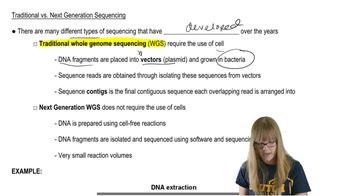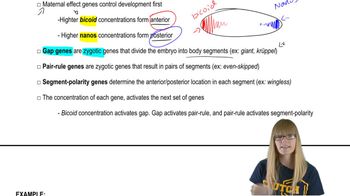Repetitive DNA poses problems for genome sequencing. Why is this so?
Table of contents
- 1. Introduction to Genetics51m
- 2. Mendel's Laws of Inheritance3h 37m
- 3. Extensions to Mendelian Inheritance2h 41m
- 4. Genetic Mapping and Linkage2h 28m
- 5. Genetics of Bacteria and Viruses1h 21m
- 6. Chromosomal Variation1h 48m
- 7. DNA and Chromosome Structure56m
- 8. DNA Replication1h 10m
- 9. Mitosis and Meiosis1h 34m
- 10. Transcription1h 0m
- 11. Translation58m
- 12. Gene Regulation in Prokaryotes1h 19m
- 13. Gene Regulation in Eukaryotes44m
- 14. Genetic Control of Development44m
- 15. Genomes and Genomics1h 50m
- 16. Transposable Elements47m
- 17. Mutation, Repair, and Recombination1h 6m
- 18. Molecular Genetic Tools19m
- 19. Cancer Genetics29m
- 20. Quantitative Genetics1h 26m
- 21. Population Genetics50m
- 22. Evolutionary Genetics29m
15. Genomes and Genomics
Sequencing the Genome
Problem 3d
Textbook Question
When the whole-genome shotgun sequence of the Drosophila genome was assembled, it comprised 134 scaffolds made up of 1636 contigs.
How can sequence gaps be closed?
 Verified step by step guidance
Verified step by step guidance1
Understand the concept of sequence gaps: Sequence gaps occur when there are regions in the genome where the sequence data is missing, often due to limitations in sequencing technology or assembly algorithms.
Identify the type of gaps: Sequence gaps can be classified as either 'physical gaps' (where no sequence data exists) or 'informational gaps' (where sequence data exists but cannot be assembled due to repetitive regions or other complexities).
Use paired-end reads or mate-pair sequencing: These techniques provide information about the relative positions of sequences on the genome, helping to bridge gaps by linking contigs that are separated by unsequenced regions.
Perform PCR amplification and Sanger sequencing: Design primers flanking the gap regions to amplify the missing sequences, followed by Sanger sequencing to close the gaps with high accuracy.
Apply gap-filling algorithms and manual curation: Use bioinformatics tools to reanalyze the assembly, leveraging known genomic features or reference genomes to resolve gaps. Manual inspection may also be necessary for complex regions.
 Verified video answer for a similar problem:
Verified video answer for a similar problem:This video solution was recommended by our tutors as helpful for the problem above
Video duration:
1mPlay a video:
Was this helpful?
Key Concepts
Here are the essential concepts you must grasp in order to answer the question correctly.
Whole-Genome Shotgun Sequencing
Whole-genome shotgun sequencing is a method used to sequence an entire genome by randomly breaking the DNA into small fragments, which are then sequenced. The resulting sequences, or reads, are assembled into longer contiguous sequences (contigs) and scaffolds. This approach allows for rapid sequencing of complex genomes, but often results in gaps that need to be addressed for complete assembly.
Recommended video:
Guided course

Sequencing Overview
Contigs and Scaffolds
Contigs are overlapping DNA segments that have been assembled into a continuous sequence, while scaffolds are larger structures that consist of multiple contigs linked together, often with gaps in between. Understanding the relationship between contigs and scaffolds is crucial for genome assembly, as closing gaps in scaffolds is essential for obtaining a complete and accurate representation of the genome.
Recommended video:
Guided course

Traditional vs. Next-Gen
Gap Closure Techniques
Gap closure techniques involve various strategies to fill in the missing sequences between contigs in a scaffold. Common methods include using paired-end reads, where two ends of a DNA fragment are sequenced, and employing PCR amplification to target specific regions. Additionally, utilizing long-read sequencing technologies can help span larger gaps, improving the overall quality and completeness of the genome assembly.
Recommended video:
Guided course

Segmentation Genes
Related Videos
Related Practice
Textbook Question
397
views


